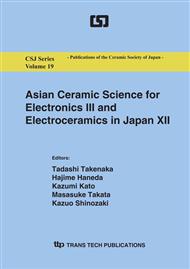[12]
single crystals. SUMMARY In summary central peaks in PLZT-x/65/35 ceramics and PMN-33%PT.
Google Scholar
[1]
oriented single crystal were studied by the high-resolution Brillouin scattering technique. In PMN-33%PT, the dynamical behavior of CPs was attributed to the presence of PNRs and domain wall movement/alignment. Whereas in PLZT ceramics, CPs resulted from growth and subsequent thermal profile of PNRs. The new intermediate temperature, Td, may be associated to the phenomenon of CPs in relaxor materials. REFERE#CES.
Google Scholar
[1]
L. E. Cross, Ferroelectrics, 76 (1987), p.241.
Google Scholar
[2]
Z. -G. Ye, Key Eng. Mater., 155-156 (1998), p.81.
Google Scholar
[3]
G. Shabbir, J. -H. Ko and S. Kojima, Appl. Phys. Lett., 86 (2005), p.12908.
Google Scholar
[4]
E. V. Colla, L. K. Chao and M. B. Weissman, Phys. Rev. B, 63 (2001), p.134107.
Google Scholar
[5]
G. Shabbir and S. Kojima, Euro. Phys. Lett., 63 (2003), p.388.
Google Scholar
[6]
Z. Kutnjak, J. Petzelt and R. Blinc, Nature, 441 (2006), p.956.
Google Scholar
[7]
A. Naberezhnov, S. B. Vakhrushev, B. Dorner and H. Moudden, Eur. Phys. J. B, 11 (1999), p.13.
Google Scholar
[8]
P. M. Gehring, S. Wakimoto, Z. -G. Ye and G. Shirane, Phys. Rev. Lett., 87 (2001), p.277601.
Google Scholar
[9]
J. Hlinka, S. Kamba, J. Petzelt, J. Kulda, C. A. Randall and S. J. Zhang, Phys. Rev. Lett., 91 (2003), p.107602.
DOI: 10.1103/physrevlett.91.107602
Google Scholar
[10]
S. Kamba, E. Buixaderas, J. Petzelt, J. Fousek, J. Nosek and P. Bridenbaugh, J. Appl. Phys., 93 (2003), p.933.
Google Scholar
[11]
S. N. Gvasaliya, B. Roessli, R. A. Cowley, S. Kojima and S. G. Lushnikov, J. Phys.: Condens. Matter., 19 (2007), p.16219.
Google Scholar
[12]
G. Shabbir and S. Kojima, Appl. Phys. Lett., 91 (2007), p.062911.
Google Scholar
[13]
F. M. Jiang and S. Kojima, Phys. Rev. B, 62 (2000), p.8572.
Google Scholar
[14]
I. G. Siny, S. G. Lushnikov, R. S. Katiyar and E. A. Rogacheva, Phys. Rev. B, 56 (1997), p.7962.
Google Scholar
[15]
G. Shabbir, S. Kojima and C. Feng, J. Appl. Phys., 100 (2006), p.064107.
Google Scholar
[16]
G. Shabbir and S. Kojima, Ferroelectrics, 303 (2004), p.167.
Google Scholar
[17]
G. Shabbir and S. Kojima, J. Phys.: Condens. Matter., 15 (2003), p.7717.
Google Scholar
[18]
J. -H. Ko, D. H. Kim and S. Kojima, Phys. Rev. B, 77 (2008), p.104110. ________________________________________ e-mail: gshabbir@gmail. com Fax.: +92-51-2208005.
Google Scholar


